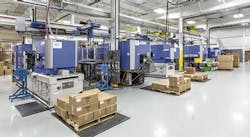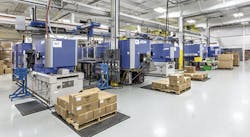Special Report: Cartesian robots change company's molding perspective
Robots were not an original part of the picture for Vision Plastics Inc., Delavan, Wis., which had an established business making small lenses and frames for high-efficiency LEDs used in architectural and street lighting.
Vision Plastics CEO and President Craig Hubertz considered robots an expensive substitute for competent machine operators.
"We've always put our money where we could get the biggest bang for the buck, usually a molding machine," he says. Justifying the cost of a robot, he believed, was more difficult.
Starting over three years ago, one of Vision's customers developed larger and brighter forms of its high-efficiency LED technology, triggering an evolution in Hubertz's thinking about robots. The use of robots started with one customer but quickly grew to several. Hubertz and his team were converted from robot skeptics to believers. Vision's production process was improved with the help of robots and the company is growing rapidly.
With the help of three-axis Cartesian robots from Sepro America LLC, Warrendale, Pa., Vision not only optimized its specialty lens production, but now has begun to automate high-value and long-cycle-time production equipment in its custom molding operations.
Vision's customer asked the company to deliver LED lenses in pre-counted stacks, properly oriented so they could be loaded directly into the customer's automated assembly equipment.
Knowing that even conscientious, experienced human operators are prone to lapses of attention, Hubertz decided to look seriously at robots. "My product was going into my customer's automation, and they're running it lights out. We couldn't afford to be the cause of a problem because we delivered a part in the wrong orientation."
So, Vision worked with Sepro to develop a simple automation cell around one of the company's JSW molding machines, using a Sepro S5-25 three-axis beam robot. The robot removes the frame from the mold, passes it by a camera for quality inspection, then places it onto stacking rods, properly oriented and counted. Each stack is then secured and packaged for delivery, ready to load into the customer's equipment, which inserts LED lenses into the frames. Vision also molds the lenses. That approach, Hubertz says, "guarantees that everything going into the customer's assembly system is properly oriented."
The customer considered that challenge met, but wasn't done. It wanted to produce bigger lenses for new LED products. These require brass sleeves molded into the corners of the lenses to prevent damage during assembly. "In the past," Hubertz explains, "we would have looked at the investment for automation and figured 'Hey, let's just load these sleeves by hand.' " Having become something of a Sepro loyalist, Hubertz decided it was not a big stretch to buy a sleeve-feeding system and use a robot on the press to load the brass sleeves into the mold.
Vision also has seen productivity and quality gains due to cycle-time improvements, with consistent, automated handling resulting in lower scrap rates. "All of this runs lights out, so I don't have to put a dedicated operator on each machine," says Hubertz. However, he's not replacing people with robots. "We have not dislocated or fired any employee due to the increased use of these robots. We have effectively used automation to improve what the operators are able to do. We've been able to deploy our operators more intelligently for greater efficiency and productivity," he says, "and our employees are actually very happy to have the robots assist them. We've been sending many of them for training to make them better equipped to work in our automated operation. The jobs they do today are more interesting and varied, and because they are more productive, pay rates have increased."
The precision and consistency of the sleeve-loading robot led Hubertz and his team to adopt a further cost-saving innovation. Up to this point, Vision had supplied lenses and frames separately to the customer, which would assemble them into finished lens modules. But, with confidence born out of the earlier automation successes, the customer simplified the product design and Vision began making the finished modules right in the mold.
With the customer's agreement and Sepro's support, Hubertz and his team have developed steadily more advanced robotic cells. For example, the company added a cell in which lenses are positioned manually into a nest on a rotary table and a camera is used to verify that the lens layout corresponds to the mold layout. Different tables are used for different molds, depending on the size and orientation of the lenses and the layout of the various molds. Then, the table rotates so that a Sepro S5-25 robot can pick up the lenses and load them into the mold. As each cycle completes, the robot's vertical arm descends to remove and hold the finished products before rotating to insert the lenses for the next mold cycle. As the mold closes, the robot places the finished parts into a marking station where they are laser-etched before being sent on a conveyor to the packaging station.
The automation improves efficiency and quality, and adds value by helping the customer improve its product.
Having seen the kind of benefits robotics bring to their lens-related operations — error-free deliveries, cost savings, higher yields, and reliable, 24/7 production — Hubertz and his team are now adding robots to their custom-molding operations, starting with high-value and long-cycle-time parts. In fact, their latest order is for a Sepro robot that will be mounted on a 650-ton Van Dorn press, bringing the benefits of automation to an older machine.
Merle R. Snyder, senior correspondent
Contact:
Sepro America LLC, 412-459-0450, www.sepro-america.com
Vision Plastics Inc., 262-728-3270, www.visionplastics.net


